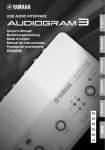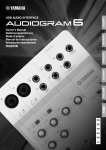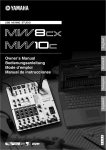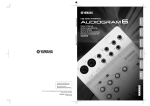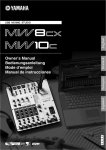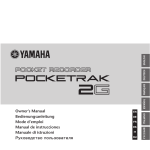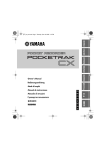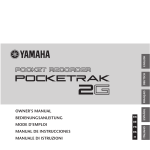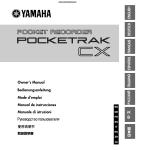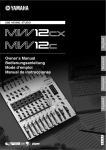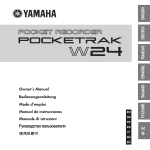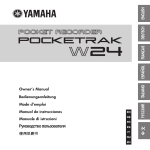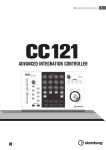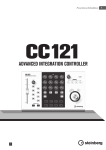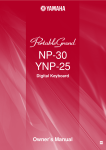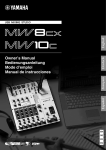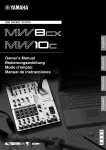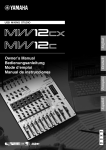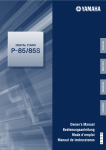Download audiogram3 owners manual
Transcript
English Owner’s Manual Bedienungsanleitung Mode d’emploi Manual de instrucciones Руководство пользователя Deutsch USB AUDIO INTERFACE USB AUDIO INTERFACE Русский Español Français 取扱説明書 Yamaha Web Site (English only) http://www.yamahasynth.com/ EN DE FR U.R.G., Pro Audio & Digital Musical Instrument Division, Yamaha Corporation © 2008 Yamaha Corporation ES RU WN49520 804POAP1.4-01A0 Printed in China JA 日本語 Yamaha Manual Library http://www.yamaha.co.jp/manual/ audiogram3_en.book Page 2 Wednesday, April 2, 2008 2:40 PM COMPLIANCE INFORMATION STATEMENT (DECLARATION OF CONFORMITY PROCEDURE) Responsible Party : Address : Telephone : Type of Equipment : Model Name : Yamaha Corporation of America 6600 Orangethorpe Ave., Buena Park, Calif. 90620 714-522-9011 COMPUTER RECORDING SYSTEM AUDIOGRAM 3 This device complies with Part 15 of the FCC Rules. Operation is subject to the following two conditions: 1) this device may not cause harmful interference, and 2) this device must accept any interference received including interference that may cause undesired operation. See user manual instructions if interference to radio reception is suspected. * This applies only to products distributed by YAMAHA CORPORATION OF AMERICA. (FCC DoC) FCC INFORMATION (U.S.A.) 1. IMPORTANT NOTICE: DO NOT MODIFY THIS UNIT! This product, when installed as indicated in the instructions contained in this manual, meets FCC requirements. Modifications not expressly approved by Yamaha may void your authority, granted by the FCC, to use the product. 2. IMPORTANT: When connecting this product to accessories and/or another product use only high quality shielded cables. Cable/s supplied with this product MUST be used. Follow all installation instructions. Failure to follow instructions could void your FCC authorization to use this product in the USA. 3. NOTE: This product has been tested and found to comply with the requirements listed in FCC Regulations, Part 15 for Class “B” digital devices. Compliance with these requirements provides a reasonable level of assurance that your use of this product in a residential environment will not result in harmful interference with other electronic devices. This equipment generates/uses radio frequencies and, if not installed and used according to the instructions found in the users manual, may cause interference harmful to the operation of other electronic devices. Compliance with FCC regulations does not guarantee that interference will not occur in all installations. If this product is found to be the source of interference, which can be determined by turning the unit “OFF” and “ON”, please try to eliminate the problem by using one of the following measures: Relocate either this product or the device that is being affected by the interference. Utilize power outlets that are on different branch (circuit breaker or fuse) circuits or install AC line filter/s. In the case of radio or TV interference, relocate/reorient the antenna. If the antenna leadin is 300 ohm ribbon lead, change the lead-in to co-axial type cable. If these corrective measures do not produce satisfactory results, please contact the local retailer authorized to distribute this type of product. If you can not locate the appropriate retailer, please contact Yamaha Corporation of America, Electronic Service Division, 6600 Orangethorpe Ave, Buena Park, CA90620 The above statements apply ONLY to those products distributed by Yamaha Corporation of America or its subsidiaries. * This applies only to products distributed by YAMAHA CORPORATION OF AMERICA. 2 AUDIOGRAM 3 Owner’s Manual (class B) audiogram3_en.book Page 3 Wednesday, April 2, 2008 2:40 PM PRECAUTIONS PLEASE READ CAREFULLY BEFORE PROCEEDING * Please keep this manual in a safe place for future reference. WARNING Always follow the basic precautions listed below to avoid the possibility of serious injury or even death from electrical shock, short-circuiting, damages, fire or other hazards. These precautions include, but are not limited to, the following: Do not open Water warning • Do not open the device or attempt to disassemble the internal parts or modify them in any way. The device contains no user-serviceable parts. If it should appear to be malfunctioning, discontinue use immediately and have it inspected by qualified Yamaha service personnel. • Do not expose the device to rain, use it near water or in damp or wet conditions, or place containers on it containing liquids which might spill into any openings. If any liquid such as water seeps into the device, unplug the USB cable from this device immediately. Then have the device inspected by qualified Yamaha service personnel. • Never insert or remove a USB cable with wet hands. CAUTION Always follow the basic precautions listed below to avoid the possibility of physical injury to you or others, or damage to the device or other property. These precautions include, but are not limited to, the following: Location Handling caution • Before moving the device, remove all connected cables. • Avoid setting all volume controls to their maximum. Depending on the condition of the connected devices, doing so may cause feedback and may damage the speakers. • Do not expose the device to excessive dust or vibrations, or extreme cold or heat (such as in direct sunlight, near a heater, or in a car during the day) to prevent the possibility of panel disfiguration or damage to the internal components. • Do not place the device in an unstable position where it might accidentally fall over. • Do not use the device in the vicinity of a TV, radio, stereo equipment, mobile phone, or other electric devices. Doing so may result in noise, both in the device itself and in the TV or radio next to it. Connections • Before connecting the device to other devices, turn off the power for all devices. Before turning the power on or off for all devices, set all volume levels to minimum. • When turning on the AC power in your audio system, always turn on monitor speakers LAST, to avoid speaker damage. When turning the power off, monitor speakers should be turned off FIRST for the same reason. • Do not insert your fingers or hands in any gaps or openings on the device. • Avoid inserting or dropping foreign objects (paper, plastic, metal, etc.) into any gaps or openings on the device. If this happens, unplug the USB cable from the device immediately. Then have the device inspected by qualified Yamaha service personnel. • Do not use the device or headphones for a long period of time at a high or uncomfortable volume level, since this can cause permanent hearing loss. If you experience any hearing loss or ringing in the ears, consult a physician. • Do not rest your weight on the device or place heavy objects on it, and avoid use excessive force on the buttons, switches or connectors. (5)-10 1/2 AUDIOGRAM 3 Owner’s Manual 3 audiogram3_en.book Page 4 Wednesday, April 2, 2008 2:40 PM MIC/INST jacks (XLR-type) are wired as follows (IEC60268 standard): pin 1: ground, pin 2: hot (+), and pin 3: cold (-). 2 1 3 Yamaha cannot be held responsible for damage caused by improper use or modifications to the device, or data that is lost or destroyed. Always unplug the USB cable from a computer or turn off the computer to turn off the device when the device is not in use. The performance of components with moving contacts, such as switches, volume controls, and connectors, deteriorates over time. Consult qualified Yamaha service personnel about replacing defective components. SPECIAL NOTICES • This manual is the exclusive copyright of Yamaha Corporation. • The included software is the exclusive copyright of Steinberg Media Technologies GmbH. • Use of the software and this manual is governed by the license agreement which the purchaser fully agrees to upon breaking the seal of the software packaging. (Please read carefully the Software Licensing Agreement at the end of this manual before installing the application.) • Copying of the software or reproduction of this manual in whole or in part by any means is expressly forbidden without the written consent of the manufacturer. • Yamaha makes no representations or warranties with regard to the use of the software and documentation and cannot be held responsible for the results of the use of this manual and the software. • This disk containing the software is not meant for use with an audio/visual system (CD player, DVD player, etc.). Do not attempt to use the disk on equipment other than a computer. • Future upgrades of application and system software and any changes in specifications and functions will be announced separately. • The screen displays as illustrated in this manual are for instructional purposes, and may appear somewhat different from the screens which appear on your computer. The illustrations and LCD screens as shown in this manual are for instructional purposes only, and may appear somewhat different from those on your instrument. This product incorporates and bundles computer programs and contents in which Yamaha owns copyrights or with respect to which it has license to use others' copyrights. Such copyrighted materials include, without limitation, all computer software, music data, etc. Any unauthorized use of such programs and contents outside of personal use is not permitted under relevant laws. Any violation of copyright has legal consequences. DON'T MAKE, DISTRIBUTE OR USE ILLEGAL COPIES. • Windows is a registered trademark of Microsoft® Corporation in the United States and other countries. • Apple, Mac and Macintosh are trademarks of Apple Inc., registered in the U.S. and other countries. • The company names and product names in this manual are the trademarks or registered trademarks of their respective companies. * Specifications and descriptions in this owner’s manual are for information purposes only. Yamaha Corp. reserves the right to change or modify products or specifications at any time without prior notice. Since specifications, equipment or options may not be the same in every locale, please check with your Yamaha dealer. 4 AUDIOGRAM 3 Owner’s Manual audiogram3_en.book Page 5 Wednesday, April 2, 2008 2:40 PM Introduction Thank you for choosing a Yamaha AUDIOGRAM 3 Computer Recording System. The AUDIOGRAM 3 includes a USB audio interface for digital audio data transfer, and Cubase AI DAW (Digital Audio Workstation) software for Windows® and Macintosh® computer operating systems. With the AUDIOGRAM 3 and your personal computer you have the basic elements of a high-performance computer recording system that is easy to set up and operate. Please read through this manual carefully before beginning use, so that you will be able to take full advantage of your interface’s superlative features and enjoy trouble-free operation for years to come. After reading the manual, please store it in a safe place. Features Connect To Your Computer via a Single USB Cable (page 8) The AUDIOGRAM interface connects to your computer via the supplied USB cable. Stereo audio data is transferred in both directions— from the interface to the computer, and viceversa—via the USB connection (44.1 kHz or 48 kHz sampling frequency). No Driver Installation Required (page 8) The AUDIOGRAM system uses the standard drivers included in your computer’s operating system, so there’s no need to install any extra driver software. Cubase AI DAW Software Supplied (page 8) Cubase AI software, included in the AUDIOGRAM package, offers versatile, high-performance hard-disk recording capability. 48V Phantom Power (page 18) A PHANTOM switch supplies +48V phantom power to the channel 1 microphone input, so you can use high-quality phantom-powered condenser microphones for superior recording quality. Accessories • Cubase AI 4 DVD-ROM • USB cable • Owner’s Manual (this book) Contents Introduction........................................ 5 Features ............................................. 5 Contents ............................................. 5 System Requirements ........................ 6 Setup ..................................................... 7 Quick Guide .......................................... 8 1. Installing Cubase AI ....................... 8 2. Connecting to the AUDIOGRAM interface......................................... 8 3. Powering Up the System ................ 9 4. Adjusting Level ............................. 10 5. Recording with Cubase AI ............ 10 6. Mixing with Cubase AI .................. 16 Controls and Functions..................... 18 Input Signal Flow .............................. 19 Troubleshooting................................. 20 Specifications................................... 128 General Specifications ................... 128 Dimensional Diagrams ................... 128 Block Diagram and Level Diagram .......................................... 129 About the accessory disk ............... 130 SOFTWARE LICENSE AGREEMENT .................................... 130 AUDIOGRAM 3 Owner’s Manual 5 audiogram3_en.book Page 6 Wednesday, April 2, 2008 2:40 PM Introduction System Requirements NOTE Visit the web address below for the latest information on: <http://www.yamahasynth.com/> Computer System Requirements Windows Vista Computer..............Windows-based computer with built-in USB interface OS ........................Windows Vista CPU......................1 GHz or higher Intel Core/Pentium/Celeron processor Memory ................1 GB or more Windows XP Computer..............Windows-based computer with built-in USB interface OS ........................Windows XP Professional/XP Home Edition CPU......................750 MHz or higher Intel Core/Pentium/Celeron processor Memory ................96 MB or more (128 MB or more recommended) Macintosh Computer..............Macintosh computer with built-in USB interface OS ........................Mac OS X 10.3.3 or higher CPU......................Macintosh G3 300 MHz or higher/Intel processor Memory ................128 MB or more Cubase AI 4 System Requirements Windows OS ........................Windows XP Professional SP1 or higher/XP Home Edition SP1 or higher/ Windows Vista (32 bit) CPU......................1.4 GHz or higher Intel Pentium processor Memory ................512 MB or more Audio Interface .....Windows DirectX/ASIO compatible Hard Disk..............1 GB or more Macintosh OS ........................Mac OS X 10.4 or higher CPU......................Power Mac G4 1 GHz/Core Solo 1.5 GHz or higher Memory ................512 MB or more Hard Disk..............1 GB or more NOTE 6 • A DVD driver is required for installation. • To activate your software license, install the application while the computer is connected to the internet. AUDIOGRAM 3 Owner’s Manual audiogram3_en.book Page 7 Wednesday, April 2, 2008 2:40 PM Setup Be sure to turn the PHANTOM +48V switch (★) on when using a phantom-powered condenser microphone. Microphone Keyboard, etc. Audio system Headphones USB cable To connect a device such as a microphone: Cubase AI Computer To connect an instrument such as an electric guitar or bass: AUDIOGRAM 3 Owner’s Manual 7 audiogram3_en.book Page 8 Wednesday, April 2, 2008 2:40 PM Quick Guide This quick setup and operation guide covers everything from installing the Cubase AI software to using Cubase AI for recording and mixdown. While going through this section you might find it useful to also refer to the “Controls and Functions” section on page 18, as well as the pdf manual supplied with the Cubase AI software. Step 1 Installing Cubase AI IMPORTANT ! 1 2 3 Since the End-User Software License Agreement (EUSLA) shown on your PC-display in your installing the “DAW” software is replaced by the agreement at the end of this manual, you should disregard the EUSLA. Read the Software License Agreement at the end of this manual carefully, and install the software if you agree to it. Start the computer and log on to the Administrator account. Insert the included DVD-ROM into the computer’s DVD-ROM drive. Double-click on the “CubaseAI4.msi” icon in the “Cubase AI 4 for Windows” folder (for Windows users), or double-click the “CubaseAI4.mpkg” in the “Cubase AI 4 for MacOS X” (for Macintosh users). Follow the on-screen instructions to install the Cubase AI software. NOTE Step 2 In order to have continuous use of Cubase AI, including support and other benefits, you will need to register the software and activate your software license by starting it while the computer is connected to the Internet. Click the “Register Now” button shown when the software is started, then fill in all required fields for registration. If you do not register the product, you will be unable to use the application after a limited period of time expires. Connecting to the AUDIOGRAM interface Be sure to turn the PHANTOM +48V switch on when using a phantom-powered condenser microphone. LEVEL controls 8 OUT LEVEL control 1 Turn all gear that is to be connected to the AUDIOGRAM off or to standby mode (except the computer), and set the LEVEL controls and OUT LEVEL control to their minimum settings. 2 Connect microphones and/or instruments. For details on making connections refer to the “Setup” section on page 7 and the “Controls and Functions” section on page 18. 3 Set the MIC/INST switch according to the type of device connected to channel 1. Select MIC ( ) if a microphone is connected, or INST ( ) if a guitar or similar instrument is connected. AUDIOGRAM 3 Owner’s Manual audiogram3_en.book Page 9 Wednesday, April 2, 2008 2:40 PM Quick Guide Step 3 Powering Up the System To prevent loud pops and noises, turn on the power to your sound gear starting with the sources (instruments, CD players, etc.) and ending with the audio system (monitor speakers). 1 2 Turn on the instruments and microphones. If you are using a condenser microphone for the channel 1, turn on the PHANTOM +48V switch. Observe the following precautions when turning on phantom power. CAUTION • Make sure that the PHANTOM +48V switch is off when phantom power is not needed. • When turning the switch on, be sure that only a condenser microphone is connected to the MIC/INST input jack. Other devices may be damaged if connected to phantom power. This precaution does not apply to balanced dynamic microphones or instruments with the phone jack, however, as these will not be affected by phantom power. • To prevent damage to speakers, be sure to turn off audio system (monitor speakers) before turning this switch on or off. We also recommend that you set the OUT LEVEL control to the minimum position before operating this switch to avoid the risk of loud noises that could cause hearing loss or device damage. 3 Connect the AUDIOGRAM interface to your computer using the supplied USB cable. The POWER indicator will light to indicate that power is being applied to the AUDIOGRAM interface. USB Connection Precautions Be sure to observe the following points when connecting to the computer's USB interface. Failure to observe these rules can result in computer freezes/hang-ups and possibly data loss or corruption. If the instrument or computer does hang up, restart the application or computer. • Be sure to wake the computer from sleep/suspended/standby mode before making a connection to the computer’s USB connector. CAUTION • Always quit all applications running on the computer before connecting or disconnecting the USB cable. • Wait at least 6 seconds between connecting or disconnecting the USB cable. When connecting or disconnecting the USB cable be sure to turn the OUT LEVEL control all the way down. CAUTION NOTE 4 The first time you connect to the computer’s USB connector, or change the connection to a different USB port, a driver installation display may appear. If this occurs, wait until the installation is complete before proceeding. Turn the power to the audio system (monitor speakers). AUDIOGRAM 3 Owner’s Manual 9 audiogram3_en.book Page 10 Wednesday, April 2, 2008 2:40 PM Quick Guide Step 1 4 Adjusting Level Adjust the volume on all instruments that are connected to the AUDIOGRAM interface. Set the OUT LEVEL control to the minimum position. Failure to do so may result in loud noise bursts that can damage your equipment, your ears, or both. CAUTION 2 Adjust the channel LEVEL controls so that the level indicator PEAK LED flash briefly on the highest peak levels. 3 Adjust the overall volume with the OUT LEVEL control while monitoring via headphones or monitor speakers. OUT LEVEL control LEVEL controls Step 5 Level indicator Recording with Cubase AI This section describes the procedure for recording to the Cubase AI software we installed earlier via the AUDIOGRAM interface. NOTE For details on operation of the Cubase AI software refer to the pdf-format manual provided with the software. Cubase AI Setup 1 Set the computer output to the maximum level. For details on how to make the setting refer to the “The recorded sound is too low in level.” section in the “Troubleshooting” on page 20. 2 Launch Cubase AI. Windows: Click [Start] → [All Program] → [Steinberg Cubase AI 4] → [Cubase AI 4] to launch the program. If the ASIO Multimedia dialog window appears, click [Yes]. 10 AUDIOGRAM 3 Owner’s Manual audiogram3_en.book Page 11 Wednesday, April 2, 2008 2:40 PM Quick Guide Macintosh: Double-click the [Application] → [Cubase AI 4]. NOTE 3 • If you specified a file destination when installing the Cubase AI software, launch the application from that location. • Create a Cubase AI shortcut or alias on your desktop so you can easily launch the program when required. Select [Device Setup] from the [Device] menu to open the Device Setup window. Windows: Select [VST Audio System] in the [Device] field on the left side of the window. Select [ASIO DirectX Full Duplex Driver] in the [ASIO Driver] field on the right side of the window. A dialog box will appear asking “Do you want to switch the ASIO driver?”. Click [Switch]. Macintosh: Select [VST Audio System] in the [Device] field on the left side of the window. Select [USB Audio CODEC (2)] in the [ASIO Driver] field on the right side of the window, and click [OK]. Skip ahead to step 7, below. NOTE 4 Under Mac OS X you can select either [USB Audio CODEC (1)] or [USB Audio CODEC (2)] in the [ASIO Driver] field. Normally you should select [USB Audio CODEC (2)], but if you will only be playing back and mixing previously recorded data you can select [USB Audio CODEC (1)] to lighten the load on the computer’s CPU. On a Windows computer select [ASIO DirectX Full Duplex Driver] in the [Devices] field on the left side of the Device Setup window, and click [Control Panel] on the right side of the window. AUDIOGRAM 3 Owner’s Manual 11 audiogram3_en.book Page 12 Wednesday, April 2, 2008 2:40 PM Quick Guide 5 The ASIO Direct Sound Full Duplex Setup dialog box will be displayed. Check only the input port and output port [USB Audio CODEC] checkbox. 6 Make sure that “USB Audio CODEC 1/2” are shown in the [Port System Name] field, and check the [Visible] column in the Device Setup window. Click [OK] to close the window. NOTE 7 Select [New Project] from the [File] menu to create a new project file. The new project dialog window will open. For this example select [CAI4 - 4 Stereo 8 Mono Audio Track Recorder] and click [OK]. NOTE 12 • If the [Port System Name] field does not change, close and restart the Cubase AI, then open the Device Setup window. • The input ports may not be shown if you are using Windows Vista. If so, refer to the “The input ports are not shown” section in the Troubleshooting section (page 20). Recorded Cubase AI data is stored as a “project file”. AUDIOGRAM 3 Owner’s Manual audiogram3_en.book Page 13 Wednesday, April 2, 2008 2:40 PM Quick Guide 8 When the directory selection dialog window appears, select the folder to which the project and audio files for the project are to be stored, and click [OK]. An empty project window with 4 stereo and 8 monaural tracks will appear. Project window Mixer window Transport panel Preparing to Record 1 Click in the track list (the area in which the track names are displayed) to select a track to record on. The various settings for the selected track are available in the Inspector on the left side of the display. [Record Enable] button Track list Inspector Input routing NOTE You will normally use a stereo track when recording synthesizers, and a monaural track when recording vocals or guitars. AUDIOGRAM 3 Owner’s Manual 13 audiogram3_en.book Page 14 Wednesday, April 2, 2008 2:40 PM Quick Guide 2 Click the Input Routing field in the Inspector to select the audio input source. Select “Stereo In 1” for a stereo track and “Left (Right)-Stereo In 1” for a monaural track. 3 Make sure the [Record Enable] button for the track to be recorded is turned on. If the [Record Enable] button is off, click it to turn it on. 4 Play the instrument to be recorded, and adjust the AUDIOGRAM LEVEL controls so that the Clipping indicator never lights. <Transport panel> 5 Clipping indicator Specify the point at which you want to start recording via the ruler at the top of the project window. Click the black area of the ruler to move the project cursor (the vertical black line) to that position. Ruler Recording and Playback 1 Click the Transport panel [Record] button to begin recording. When recording is started the project cursor will begin moving to the right and a box that displays the recording results will be created. <Transport panel> Start Rewind 2 3 14 Forward Stop Record Recording results Play the part. When you finish recording the track, click the Transport panel [Stop] button. AUDIOGRAM 3 Owner’s Manual audiogram3_en.book Page 15 Wednesday, April 2, 2008 2:40 PM Quick Guide 4 To hear playback of the track you have just recorded, use either the Transport panel [Rewind] button or the ruler to rewind to the beginning of the recorded section, then click the Transport panel [Start] button. The overall playback level will be displayed via the master section bus level meter on the right side of the mixer window, and the channel level will be displayed via the channel strip level meter. NOTE • Click the [Narrow/Wide] button in the upper left corner of the mixer window to increase the width of the mixer’s channel strips. • To hear the playback sound via the AUDIOGRAM interface, adjust the volume with the OUT LEVEL control. The playback level will approximately match the recording level when the computer output is set to the maximum level. [Narrow/Wide] button Level meter [Narrow/Wide] button Bus level meter 5 To save the project file select [Save] from the [File] menu and enter a file name before actually saving the file. Save your project file frequently to insure against losing large amounts of data if a problem occurs. 6 7 Repeat steps 1 through 5 to record further material on the same track. To record additional material on a different track, select a new track and repeat the record procedure. Recording with maximum quality and minimum noise: For optimum sound quality with minimum noise, the AUDIOGRAM signal levels should be set as high as possible without clipping. Check signal levels to be sent to Cubase AI for recording using the AUDIOGRAM level indicators while the Cubase monitoring button ( ) is turned off. Adjust the channel LEVEL controls so that the level indicator PEAK LEDs flash only occasionally on the highest input transients. Monitoring button AUDIOGRAM 3 Owner’s Manual 15 audiogram3_02.fm Page 16 Thursday, November 6, 2008 11:44 AM Quick Guide Step 6 Mixing with Cubase AI In this section we’ll try mixing down multiple recorded audio tracks to stereo, and creating a wav file. Mixes can be stored as WAV or AIFF files, which can then be recorded to audio CDs. 1 2 3 Launch Cubase AI and open a project file. 4 Drag the pan controls on the top of the channel strips left and right to set the stereo position of each track. 5 At this point you can begin to use EQ to refine your mix, and add effects. As an example let’s try adding reverb. Click the [Edit] button ( ) on the left side of the channel strip to open the VST audio channel settings window. Click Insert 1 and select Reverb - RoomWorks SE. Click the [Start] button on the Transport Panel. While listening to playback, drag the channel strip level faders up and down to create the desired initial balance, then adjust the overall volume using the bus volume fader. NOTE For further details refer to the pdf manual provided with the Cubase AI software. It’s a good idea to lower the channel fader a bit before adding an effect, since the effect can cause an increase in the overall channel level. CAUTION 6 16 When the final mix adjustments have been made, go to the [File] menu and select [Export] → [Audio Mixdown]. AUDIOGRAM 3 Owner’s Manual audiogram3_en.book Page 17 Wednesday, April 2, 2008 2:40 PM Quick Guide 7 Enter a file name and select a destination for the file as well as a file type. If you intend to use the file to create an audio CD, select the WAV file type (AIFF on Macintosh OS X), Stereo Out (stereo), 44.1 kHz, and 16 bit. 8 Click [Export]. Progress of the mixdown operation will be shown in a progress window. When the progress window closes the mixdown is complete. NOTE Files created by mixdown can be directly played back using the Windows Media Player, or iTunes. AUDIOGRAM 3 Owner’s Manual 17 audiogram3_en.book Page 18 Wednesday, April 2, 2008 2:40 PM Controls and Functions Control Panel u q ew 1 PHANTOM +48V Switch/Indicator This switch toggles phantom power on and off. If you set the switch on ( ), the AUDIOGRAM supplies phantom power to the MIC/INST jack (XLR-type) 8. Turn this switch on when using a phantom-powered condenser microphone. CAUTION • Be sure to leave this switch off ( ) if you do not need phantom power. • When turning the switch on, be sure that only a condenser microphone is connected to the MIC/ INST input jack. Other devices may be damaged if connected to phantom power. This precaution does not apply to balanced dynamic microphones or instruments with the phone jack, however, as these will not be affected by phantom power. • To prevent damage to speakers, be sure to turn off audio system (monitor speakers) before turning this switch on or off. We also recommend that you set the OUT LEVEL control to the minimum position. Neglect of these precautions may result in large noise bursts that may damage your equipment, your ears, or both. 2 MIC/INST Switch Set this switch according to the type of device connected. Select MIC ( ) if a microphone is connected, or INST ( ) if an electric guitar or bass is connected. If a device is not connected to the NOTE MIC/INST jack, set this switch to MIC ( ). Otherwise noise may occur. 18 AUDIOGRAM 3 Owner’s Manual e t yr 3 LEVEL Controls Adjusts the level of the channel signal. Use these controls to adjust the balance between the channels. 4 POWER Indicator This indicator lights when power is applied to the AUDIOGRAM interface via the USB cable (supplied) that connects it to the computer. 5 Level Indicators These indicators show signal levels prior to the OUT LEVEL control 6. The SIGNAL LED lights when a signal is present, and the PEAK LED lights when the signal reaches or exceeds clipping level. Adjust the input channel LEVEL controls 3 so that the PEAK LEDs flash only briefly on occasional high-level peaks or not at all. 6 OUT LEVEL Control Adjusts the signal level sent to the STEREO OUT jacks 0. This allows you to adjust the overall volume without changing the relative volume balance among the channels. CAUTION When connecting or disconnecting the USB or audio cables be sure to turn the OUT LEVEL control all the way down. 7 USB Connector Connects the AUDIOGRAM interface to a USB port on your computer via the supplied USB cable. In addition to transferring audio data between the AUDIOGRAM interface and the computer, the USB cable supplies power from the computer to the AUDIOGRAM interface. Yamaha recommends that you NOTE use a USB cable with a length of 1.5 meter or less. audiogram3_en.book Page 19 Wednesday, April 2, 2008 2:40 PM Controls and Functions Rear Panel !1 !0 o 8 MIC/INST Input Jack If devices are connected to both phone and pin jacks, only the signal from the device connected to the phone jacks is input. Microphones and instruments such as guitars can be connected here using XLR or phone jack cables. Set the MIC/INST switch 2 to MIC or INST according to the type of device connected. XLR-type i Pin-type Phone-type Phone-type 0 STEREO OUT Jacks NOTE These output the mixed signal from channels 1 and 2. The output level can be adjusted using the OUT LEVEL control. These jacks would typically be connected to an audio system (monitor speakers). You can directly connect an electric guitar or bass without the need for a separate DI (Direct Injection) box or amp simulator. NOTE 9 LINE Input Jacks These inputs are intended mainly for use with instruments and equipment having stereo outputs, such as a synthesizer or CD player. You can use either the phone jacks or pin jacks but not both at the same time. If both jacks are used, the signal is only output from the phone jacks. A PHONES Jack Connects a pair of headphones to this jack. The PHONES jack outputs the same signal as the STEREO OUT jacks. ■ Input Signal Flow 5 Level indicator Adjust the recording level as well as the balance between channels. Input 3 LEVEL Record controls Playback Adjusts the monitor level. 6 OUT LEVEL control Output Cubase AI AUDIOGRAM 3 Owner’s Manual 19 audiogram3_en.book Page 20 Wednesday, April 2, 2008 2:40 PM Troubleshooting The AUDIOGRAM interface won’t turn on. ❑ Is the included USB cable properly plugged into the interface and a computer? The system doesn’t work properly. ❑ Are the USB cable and all necessary audio cables properly connected? ❑ Are you using a USB hub? USB hubs can interfere with proper operation, so try connecting the AUDIOGRAM interface directly to a USB port on the computer. If the computer has multiple USB ports, try a different USB port. ❑ Are you using other USB devices at the same time? If so, try removing the other device(s) and connecting only the Yamaha USB device. The Input ports are not shown (Windows Vista) ❑ Is the sound input of your computer operating system assigned properly? 1. From the [START] menu click [Control Panel], then double-click the “Sound” icon to open the “Sound” dialog window. 2. Click the “Recording” tab, right-click the “USB Audio CODEC” icon and select “Properties.” 3. Click the “Advanced” tab, then select “2 channel, 16 bit, 44100 Hz (CD Quality)” or “2 channel, 16 bit, 48000 Hz (DVD Quality)” in the “Default Format” field. No sound. ❑ Are your speaker cables connected properly, or are they shorted? ❑ Are the volume controls of your sources, audio devices, applications software, computer operating system, etc., set at appropriate levels? ❑ Is the output of your computer operating system muted? ❑ Do you have several applications running at the same time? Be sure to quit all applications you are not using. ❑ Is the sound output of your computer operating system assigned properly? Windows Vista: 1. From the [START] menu click [Control Panel], then double-click the “Sound” icon to open the “Sound” dialog window. 2. Click the “Playback” tab and check whether the “USB Audio CODEC” icon is checked. If not, right-click the “USB Audio CODEC” icon and select “Set as Default Device.” 3. Click the [Recording] tab and check whether the “USB Audio CODEC” icon is checked. If not, right-click the “USB Audio CODEC" icon and select "Set as Default Device.” Windows XP: 1. From the [START] menu click [Control Panel], then double-click the “Sounds and Audio Devices” icon to open the “Sounds and Audio Devices Properties” dialog window. 2. Click the “Audio” tab. 3. Set “Sound playback: Default device” and “Sound recording: Default device” to “USB Audio CODEC.” 4. Click [OK]. 20 AUDIOGRAM 3 Owner’s Manual audiogram3_en.book Page 21 Wednesday, April 2, 2008 2:40 PM Troubleshooting Macintosh: 1. Select “System Preferences ...” from the Apple menu and then select “Sound” to open the “Sound” dialog window. 2. Click the “Input” tab and under “Choose a device for sound input” select “USB Audio CODEC”. 3. Click the “Output” tab and under “Choose a device for sound output” select “USB Audio CODEC”. ❑ Is the sound output of the Cubase AI application assigned properly? For setup details refer to page 8 of the Quick Guide. The recorded sound is too low in level. ❑ Is the computer’s output level setting too low? We recommend that you set the computer output to the maximum level and mute the computer’s internal speaker. Windows Vista: 1. From the [START] menu click [Control Panel], then double-click the “Sound” icon to open the “Sound” dialog window. 2. Click the “Playback” tab, right-click the “USB Audio CODEC” icon and select “Properties”. 3. Click the “Levels” tab, then set the volume slider to its maximum level. Close the “Properties” dialog window. 4. Click the “Sounds” tab in the “Sound” dialog window, then select “No sounds” in the “Sound Scheme.” Windows XP: 1. From the [START] menu click [Control Panel], then double-click the “Sounds and Audio Devices” icon to open the “Sounds and Audio Devices Properties” dialog window. 2. Click the “Volume” tab. 3. Set “Device volume” to “High.” 4. Click the “Sound” tab. 5. Select “No sound” in the “Sound scheme.” Macintosh: 1. Select [System Preferences ...] from the Apple menu and then select “Sound” to open the “Sound” dialog window. 2. Click the “Output” tab and set the volume slider at the bottom of the window to its maximum level. 3. Click the “Sound Effect” tab and set the volume slider of the “Alert volume” slider to its minimum level. ❑ Have you connected or disconnected the USB cable while Cubase AI is running? Doing so can sometimes cause the Windows output level to be reset to its default level. Check and raise the output level if necessary. AUDIOGRAM 3 Owner’s Manual 21 audiogram3_en.book Page 22 Wednesday, April 2, 2008 2:40 PM Troubleshooting The sound is intermittent or distorted. ❑ Is the PEAK LED flashing red? You might have to lower LEVEL control levels to avoid distortion. ❑ Does the computer you are using meet the listed system requirements? Refer to “Computer System Requirements” on page 6 for details. ❑ Are any other applications, device drivers, or USB devices (scanners, printers, etc.) running at the same time? Be sure to quit all applications you are not using. ❑ Are you playing back a large number of audio tracks? The number of tracks you can play at the same time will depend on the performance of the computer you are using. You may experience intermittent playback if you exceed your computer’s capabilities. ❑ Are you recording or playing long continuous sections of audio? The audio data processing capabilities of your computer will depend on a number of factors including CPU speed and access to external devices. On Windows XP computers, changing some settings as outlined below can improve performance. 1. Click [Control Panel] from the [START] menu, and double-click the “Sounds and Audio Devices” icon to open the “Sounds and Audio Devices Properties” dialog window. 2. Click the “Volume” tab and click “Advanced” in “Speaker settings.” The “Advanced Audio Properties” dialog window will open. 3. Click the “Performance” tab. Set “Hardware acceleration” to “Full”, and “Sample rate conversion quality” to “Good.” Don’t change these settings if you are not familiar with your computer’s operating system. Check that the file system is set properly, and make sure that you have a plenty of free memory (more than 128 megabytes). If the wave files you are recording or playing are not too large, changing the virtual memory settings can sometimes improve audio performance. In some cases it might be necessary to update your hard disk controller, device drivers, or BIOS. Refer to your computer’s support center or support page on the web for more information. ❑ Try adding memory. Adding more RAM memory can significantly increase your computer’s audio performance. Refer to your computer’s owner’s manual for information on installing and setting up extra memory. There is a delay when playing a software synthesizer via a MIDI keyboard (latency). ❑ Check the URL listed below for the latest information. <http://www.yamahasynth.com/> 22 AUDIOGRAM 3 Owner’s Manual audiogram3_en.book Page 128 Wednesday, April 2, 2008 2:40 PM Specifications ■ General Specifications Jacks MIC/INST Input Jack LINE Input Jacks (L, R) PHONES Jack STEREO OUT Jacks (L, R) Controls Indicators USB Connector MIC/INST Switch LEVEL Control PHANTOM +48V Switch OUT LEVEL Control Phantom Power Level Indicators Power Power Supply Dimensions (W x H x D) Net Weight Included Accessories x1 x1 x1 x1 x1 x1 x1 x1 Combo jack (Mic/HiZ) Phone jacks RCA pin jacks Phone jack Phone jacks RCA pin jacks USB 1.1 44.1/48 kHz, 16 bit MIC: for microphones INST (Hi-Z): for guitars, etc. x2 Adjust the level of CH 1, 2 x1 48 V, only for CH1 x1 Adjusts the overall signal x1 Red x1 2 points (green, red) x1 Green USB bus-powered 180 x 61 x 112 mm 490 g Cubase AI 4 DVD-ROM USB cable Owner’s Manual ■ Dimensional Diagrams W: 180 H: 61 52 2 108 D: 112 36 Unit: mm 128 AUDIOGRAM 3 Owner’s Manual +30dBu +20dBu +10dBu 0dBu –10dBu –20dBu –30dBu –40dBu –50dBu –60dBu MIC B [–60 to –16dBu] INST [–44 to 0dBu] INPUT 1 MIC A [–60 to –16dBu] AUDIOGRAM 3 Owner’s Manual CH IN MIC Gain: Max [–60dBu] CH IN INST Gain: Max [–44dBu] CH IN MIC Gain: Min [–16dBu] CH IN INST Gain: Min [0dBu] LINE R [–34 to +10dBu] [–6dBu] Level (Gain) [6 to 50dB] HA HA ST CH IN LINE Gain: Max [–34dBu] Clip Level [–6dBu] Level (Gain) [10 to 54dB] HA ST CH IN LINE Gain: Min [+10dBu] Clip Level Hi-Z PHANTOM (+48V) MIC/INST LINE L [–34 to +10dBu] INPUT 2 COMBO SUM SUM [–6dBu] RE GR D– D+ GND +3.7V USB DC-DC Level (MASTER) [Nominal: –6dB] DC-DC PHONES [0.5mW @ 40ohms] STEREO OUT [–2dBu] Clip Level IN OUT1 SW_IC EN1 OUT2 EN2 12MHz USB REG [–20dBu] AUDIO Vbus (+5V) LO SSPND RO DC-DC LPF LPF LPF [–20dBu] LIN RIN –7.5V RE GR [–6dBu] L R [–2dBu] MUTE BA BA DR LPF Level (MASTER) [–12dBu] +7.5V +48V PHANTOM +5V POWER SUM SUM [–6dBu] DR PEAK SIGNAL STEREO OUT [–2dBu] +30dBu +20dBu +10dBu 0dBu –10dBu –20dBu –30dBu –40dBu –50dBu –60dBu PHONES [0.5mW @ 40ohms] R L audiogram3_en.book Page 129 Wednesday, April 2, 2008 2:40 PM Specifications ■ Block Diagram and Level Diagram 129 STEREO L STEREO R audiogram3_en.book Page 130 Wednesday, April 2, 2008 2:40 PM About the accessory disk SPECIAL NOTICE • The software included in the accessory disk and the copyrights thereof are under exclusive ownership by Steinberg Media Technologies GmbH. • Use of the software and this manual is governed by the license agreement which the purchaser fully agrees to upon breaking the seal of the software packaging. (Please read carefully the Software Licensing Agreement at the end of this manual before installing the application.) • Copying of the software or reproduction of this manual in whole or in part by any means is expressly forbidden without the written consent of the manufacturer. • Yamaha makes no representations or warranties with regard to the use of the software and documentation and cannot be held responsible for the results of the use of this manual and the software. • This disk is NOT for audio/visual purpose. Do not attempt to play the disk on an audio/visual CD/DVD player. Doing so may result in irreparable damage to your player. • For information about the minimum system requirements and latest information of the software in the disk, check the web site below. <http://www.yamahasynth.com/> • Note that Yamaha does not offer technical support for the DAW software in the accessory disk. About the DAW software in the accessory disk The accessory disk contains DAW software both for Windows and Macintosh. NOTE • Make sure to install DAW software under the “Administrator” account. • In order to have continuous use of the DAW software in the accessory disk, including support and other benefits, you will need to register the software and activate your software license by starting it while the computer is connected to the Internet. Click the “Register Now” button shown when the software is started, then fill in all required fields for registration. If you do not register the software, you will be unable to use it after a limited period of time expires. • If you are using a Macintosh computer, double-click the “***.mpkg” file to start installation. For information about the minimum system requirements and latest information on the software in the disk, check the web site below. <http://www.yamahasynth.com/> About software support Support for the DAW software in the accessory disk is provided by Steinberg on its website at the following address. http://www.steinberg.net You can visit the Steinberg site also via the Help menu of the included DAW software. (The Help menu also includes the PDF manual and other information on the software.) ATTENTION SOFTWARE LICENSE AGREEMENT PLEASE READ THIS SOFTWARE LICENSE AGREEMENT (“AGREEMENT”) CAREFULLY BEFORE USING THIS SOFTWARE. YOU ARE ONLY PERMITTED TO USE THIS SOFTWARE PURSUANT TO THE TERMS AND CONDITIONS OF THIS AGREEMENT. THIS AGREEMENT IS BETWEEN YOU (AS AN INDIVIDUAL OR LEGAL ENTITY) AND YAMAHA CORPORATION (“YAMAHA”). BY BREAKING THE SEAL OF THIS PACKAGE YOU ARE AGREEING TO BE BOUND BY THE TERMS OF THIS LICENSE. IF YOU DO NOT AGREE WITH THE TERMS, DO NOT INSTALL, COPY, OR OTHERWISE USE THIS SOFTWARE. THIS AGREEMENT PROVIDES YOUR USE-CONDITIONS ABOUT THE “DAW” SOFTWARE OF STEINBERG MEDIA TECHNOLOGIES GMBH(“STEINBERG”) WHICH IS BUNDLED WITH THIS PRODUCT. SINCE THE END-USER SOFTWARE LICENSE AGREEMENT (EUSLA) SHOWN ON YOUR PC-DISPLAY IN YOUR INSTALLING THE “DAW” SOFTWARE IS REPLACED BY THIS AGREEMENT, YOU SHOULD DISREGARD THE EUSLA. THAT IS, IN THE INSTALLING PROCESS, YOU SHOULD SELECT “AGREE” WITH THE EUSLA, WITHOUT YOUR JUDGMENT THERETO, SO AS TO PROCEED TO THE NEXT PAGE. 1. GRANT OF LICENSE AND COPYRIGHT Yamaha hereby grants you the right to use one copy of the software program(s) and data (“SOFTWARE”) accompanying this Agreement. The term SOFTWARE shall encompass any updates to the accompanying software and data. The SOFTWARE is owned by STEINBERG, and is protected by relevant copyright laws and all applicable 130 AUDIOGRAM 3 Owner’s Manual treaty provisions. Yamaha has acquired the sublicense right to license you to use the SOFTWARE. While you are entitled to claim ownership of the data created with the use of SOFTWARE, the SOFTWARE will continue to be protected under relevant copyrights. • You may use the SOFTWARE on a single computer. audiogram3_en.book Page 131 Wednesday, April 2, 2008 2:40 PM • You may make one copy of the SOFTWARE in machine-readable form for backup purposes only, if the SOFTWARE is on media where such backup copy is permitted. On the backup copy, you must reproduce Yamaha’s copyright notice and any other proprietary legends that were on the original copy of the SOFTWARE. • You may permanently transfer to a third party all your rights in the SOFTWARE only when you transfer this product together, provided that you do not retain any copies and the recipient reads and agrees to the terms of this Agreement. 2. RESTRICTIONS • You may not engage in reverse engineering, disassembly, decompilation or otherwise deriving a source code form of the SOFTWARE by any method whatsoever. • You may not reproduce, modify, change, rent, lease, or distribute the SOFTWARE in whole or in part, or create derivative works of the SOFTWARE. • You may not electronically transmit the SOFTWARE from one computer to another or share the SOFTWARE in a network with other computers. • You may not use the SOFTWARE to distribute illegal data or data that violates public policy. • You may not initiate services based on the use of the SOFTWARE without permission by Yamaha Corporation. Copyrighted data, including but not limited to MIDI data for songs, obtained by means of the SOFTWARE, are subject to the following restrictions which you must observe. • Data received by means of the SOFTWARE may not be used for any commercial purposes without permission of the copyright owner. • Data received by means of the SOFTWARE may not be duplicated, transferred, or distributed, or played back or performed for listeners in public without permission of the copyright owner. • The encryption of data received by means of the SOFTWARE may not be removed nor may the electronic watermark be modified without permission of the copyright owner. 3. TERMINATION This Agreement becomes effective on the day that you receive the SOFTWARE and remains effective until terminated. If any copyright law or provisions of this Agreement is violated, the Agreement shall terminate automatically and immediately without notice from Yamaha. Upon such termination, you must immediately destroy the licensed SOFTWARE, any accompanying written documents and all copies thereof. 4. LIMITED WARRANTY ON MEDIA As to SOFTWARE sold on tangible media, Yamaha warrants that the tangible media on which the SOFTWARE is recorded will be free from defects in materials and workmanship under normal use for a period of fourteen (14) days from the date of receipt, as evidenced by a copy of the receipt. Yamaha’s entire liability and your exclusive remedy will be replacement of the defective media if it is returned to Yamaha or an authorized Yamaha dealer within fourteen days with a copy of the receipt. Yamaha is not responsible for replacing media damaged by accident, abuse or misapplication. TO THE FULLEST EXTENT PERMITTED BY LAW, YAMAHA EXPRESSLY DISCLAIMS ANY IMPLIED WARRANTIES ON THE TANGIBLE MEDIA, INCLUDING THE IMPLIED WARRANTIES OF MERCHANTABILITY AND FITNESS FOR A PARTICULAR PURPOSE. 5. DISCLAIMER OF WARRANTY ON SOFTWARE You expressly acknowledge and agree that use of the SOFTWARE is at your sole risk. The SOFTWARE and related documentation are provided “AS IS” and without warranty of any kind. NOTWITHSTANDING ANY OTHER PROVISION OF THIS AGREEMENT, YAMAHA EXPRESSLY DISCLAIMS ALL WARRANTIES AS TO THE SOFTWARE, EXPRESS, AND IMPLIED, INCLUDING BUT NOT LIMITED TO THE IMPLIED WARRANTIES OF MERCHANTABILITY, FITNESS FOR A PARTICULAR PURPOSE AND NON-INFRINGEMENT OF THIRD PARTY RIGHTS. SPECIFICALLY, BUT WITHOUT LIMITING THE FOREGOING, YAMAHA DOES NOT WARRANT THAT THE SOFTWARE WILL MEET YOUR REQUIREMENTS, THAT THE OPERATION OF THE SOFTWARE WILL BE UNINTERRUPTED OR ERROR-FREE, OR THAT DEFECTS IN THE SOFTWARE WILL BE CORRECTED. 6. LIMITATION OF LIABILITY YAMAHA’S ENTIRE OBLIGATION HEREUNDER SHALL BE TO PERMIT USE OF THE SOFTWARE UNDER THE TERMS HEREOF. IN NO EVENT SHALL YAMAHA BE LIABLE TO YOU OR ANY OTHER PERSON FOR ANY DAMAGES, INCLUDING, WITHOUT LIMITATION, ANY DIRECT, INDIRECT, INCIDENTAL OR CONSEQUENTIAL DAMAGES, EXPENSES, LOST PROFITS, LOST DATA OR OTHER DAMAGES ARISING OUT OF THE USE, MISUSE OR INABILITY TO USE THE SOFTWARE, EVEN IF YAMAHA OR AN AUTHORIZED DEALER HAS BEEN ADVISED OF THE POSSIBILITY OF SUCH DAMAGES. In no event shall Yamaha’s total liability to you for all damages, losses and causes of action (whether in contract, tort or otherwise) exceed the amount paid for the SOFTWARE. 7. GENERAL This Agreement shall be interpreted according to and governed by Japanese law without reference to principles of conflict of laws. Any dispute or procedure shall be heard before the Tokyo District Court in Japan. If for any reason a court of competent jurisdiction finds any portion of this Agreement to be unenforceable, the remainder of this Agreement shall continue in full force and effect. 8. COMPLETE AGREEMENT This Agreement constitutes the entire agreement between the parties with respect to use of the SOFTWARE and any accompanying written materials and supersedes all prior or contemporaneous understandings or agreements, written or oral, regarding the subject matter of this Agreement. No amendment or revision of this Agreement will be binding unless in writing and signed by a fully authorized representative of Yamaha. AUDIOGRAM 3 Owner’s Manual 131 audiogram3_en.book Page 143 Wednesday, April 2, 2008 2:40 PM For details of products, please contact your nearest Yamaha representative or the authorized distributor listed below. Pour plus de détails sur les produits, veuillez-vous adresser à Yamaha ou au distributeur le plus proche de vous figurant dans la liste suivante. Die Einzelheiten zu Produkten sind bei Ihrer unten aufgeführten Niederlassung und bei Yamaha Vertragshändlern in den jeweiligen Bestimmungsländern erhältlich. Para detalles sobre productos, contacte su tienda Yamaha más cercana o el distribuidor autorizado que se lista debajo. POLAND NORTH AMERICA CANADA Yamaha Canada Music Ltd. 135 Milner Avenue, Scarborough, Ontario, M1S 3R1, Canada Tel: 416-298-1311 U.S.A. Yamaha Corporation of America 6600 Orangethorpe Ave., Buena Park, Calif. 90620, U.S.A. Tel: 714-522-9011 CENTRAL & SOUTH AMERICA MEXICO Yamaha de México S.A. de C.V. Calz. Javier Rojo Gómez #1149, Col. Guadalupe del Moral C.P. 09300, México, D.F., México Tel: 55-5804-0600 OTHER COUNTRIES Yamaha Music Central Europe GmbH Sp.z. o.o. Oddzial w Polsce ul. 17 Stycznia 56, PL-02-146 Warszawa, Poland Tel: 022-868-07-57 THE NETHERLANDS/ BELGIUM/LUXEMBOURG Yamaha Music Central Europe GmbH, Branch Benelux Clarissenhof 5-b, 4133 AB Vianen, The Netherlands Tel: 0347-358 040 FRANCE Yamaha Musique France BP 70-77312 Marne-la-Vallée Cedex 2, France Tel: 01-64-61-4000 ITALY BRAZIL Yamaha Musical do Brasil Ltda. Rua Joaquim Floriano, 913 - 4' andar, Itaim Bibi, CEP 04534-013 Sao Paulo, SP. BRAZIL Tel: 011-3704-1377 ARGENTINA Yamaha Music Latin America, S.A. Sucursal de Argentina Olga Cossettini 1553, Piso 4 Norte Madero Este-C1107CEK Buenos Aires, Argentina Tel: 011-4119-7000 PANAMA AND OTHER LATIN AMERICAN COUNTRIES/ CARIBBEAN COUNTRIES Yamaha Musica Italia S.P.A. Combo Division Viale Italia 88, 20020 Lainate (Milano), Italy Tel: 02-935-771 SPAIN/PORTUGAL Yamaha Música Ibérica, S.A. Ctra. de la Coruna km. 17, 200, 28230 Las Rozas (Madrid), Spain Tel: 91-639-8888 SWEDEN Yamaha Scandinavia AB J. A. Wettergrens Gata 1, Box 30053 S-400 43 Göteborg, Sweden Tel: 031 89 34 00 DENMARK Yamaha Music Latin America, S.A. Torre Banco General, Piso 7, Urbanización Marbella, Calle 47 y Aquilino de la Guardia, Ciudad de Panamá, Panamá Tel: +507-269-5311 EUROPE YS Copenhagen Liaison Office Generatorvej 6A, DK-2730 Herlev, Denmark Tel: 44 92 49 00 NORWAY Norsk filial av Yamaha Scandinavia AB Grini Næringspark 1, N-1345 Østerås, Norway Tel: 67 16 77 70 RUSSIA THE UNITED KINGDOM Yamaha Music U.K. Ltd. Sherbourne Drive, Tilbrook, Milton Keynes, MK7 8BL, England Tel: 01908-366700 GERMANY Yamaha Music Central Europe GmbH Siemensstraße 22-34, 25462 Rellingen, Germany Tel: 04101-3030 SWITZERLAND/LIECHTENSTEIN Yamaha Music Central Europe GmbH, Branch Switzerland Seefeldstrasse 94, 8008 Zürich, Switzerland Tel: 01-383 3990 AUSTRIA Yamaha Music Central Europe GmbH, Branch Austria Schleiergasse 20, A-1100 Wien, Austria Tel: 01-60203900 CZECH REPUBLIC/SLOVAKIA/ HUNGARY/SLOVENIA Yamaha Music Central Europe GmbH, Branch Austria, CEE Department Schleiergasse 20, A-1100 Wien, Austria Tel: 01-602039025 Yamaha Music (Russia) Office 4015, entrance 2, 21/5 Kuznetskii Most street, Moscow, 107996, Russia Tel: 495 626 0660 OTHER EUROPEAN COUNTRIES Yamaha Music Central Europe GmbH Siemensstraße 22-34, 25462 Rellingen, Germany Tel: +49-4101-3030 AFRICA Yamaha Corporation, Asia-Pacific Music Marketing Group Nakazawa-cho 10-1, Naka-ku, Hamamatsu, Japan 430-8650 Tel: +81-53-460-2313 MIDDLE EAST TURKEY/CYPRUS Yamaha Music Central Europe GmbH Siemensstraße 22-34, 25462 Rellingen, Germany Tel: 04101-3030 Yamaha Music Gulf FZE LOB 16-513, P.O.Box 17328, Jubel Ali, Dubai, United Arab Emirates Tel: +971-4-881-5868 ASIA THE PEOPLE’S REPUBLIC OF CHINA Yamaha Music & Electronics (China) Co.,Ltd. 25/F., United Plaza, 1468 Nanjing Road (West), Jingan, Shanghai, China Tel: 021-6247-2211 INDONESIA PT. Yamaha Music Indonesia (Distributor) PT. Nusantik Gedung Yamaha Music Center, Jalan Jend. Gatot Subroto Kav. 4, Jakarta 12930, Indonesia Tel: 21-520-2577 KOREA Yamaha Music Korea Ltd. 8F, 9F, Dongsung Bldg. 158-9 SamsungDong, Kangnam-Gu, Seoul, Korea Tel: 080-004-0022 MALAYSIA Yamaha Music Malaysia, Sdn., Bhd. Lot 8, Jalan Perbandaran, 47301 Kelana Jaya, Petaling Jaya, Selangor, Malaysia Tel: 3-78030900 SINGAPORE Yamaha Music Asia Pte., Ltd. #03-11 A-Z Building 140 Paya Lebor Road, Singapore 409015 Tel: 747-4374 TAIWAN Yamaha KHS Music Co., Ltd. 3F, #6, Sec.2, Nan Jing E. Rd. Taipei. Taiwan 104, R.O.C. Tel: 02-2511-8688 THAILAND Siam Music Yamaha Co., Ltd. 891/1 Siam Motors Building, 15-16 floor Rama 1 road, Wangmai, Pathumwan Bangkok 10330, Thailand Tel: 02-215-2626 OTHER ASIAN COUNTRIES Yamaha Corporation, Asia-Pacific Music Marketing Group Nakazawa-cho 10-1, Naka-ku, Hamamatsu, Japan 430-8650 Tel: +81-53-460-2317 OCEANIA AUSTRALIA Yamaha Music Australia Pty. Ltd. Level 1, 99 Queensbridge Street, Southbank, Victoria 3006, Australia Tel: 3-9693-5111 COUNTRIES AND TRUST TERRITORIES IN PACIFIC OCEAN Yamaha Corporation, Asia-Pacific Music Marketing Group Nakazawa-cho 10-1, Naka-ku, Hamamatsu, Japan 430-8650 Tel: +81-53-460-2313 HEAD OFFICE Yamaha Corporation, Pro Audio & Digital Musical Instrument Division Nakazawa-cho 10-1, Naka-ku, Hamamatsu, Japan 430-8650 Tel: +81-53-460-2441 PA20 Yamaha Web Site (English only) http://www.yamahasynth.com/ Yamaha Manual Library http://www.yamaha.co.jp/manual/ U.R.G., Pro Audio & Digital Musical Instrument Division, Yamaha Corporation © 2008 Yamaha Corporation WN49520 811POAPx.x-xxB0 Printed in China




























